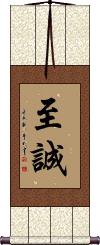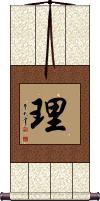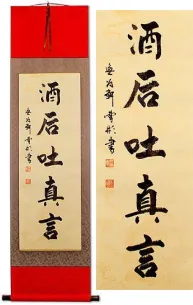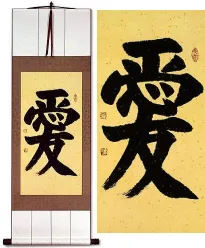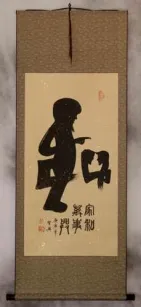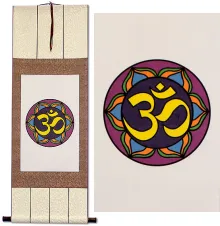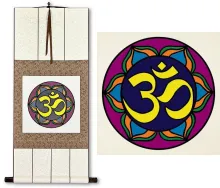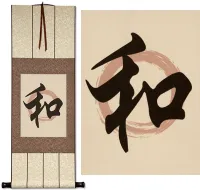Many custom options...
And formats...

Universal Truth in Chinese / Japanese...
Buy an Universal Truth calligraphy wall scroll here!
Personalize your custom “Universal Truth” project by clicking the button next to your favorite “Universal Truth” title below...
Sincerity and Devotion
至誠 is the idea that you enter into something with the utmost sincerity and fidelity. Ideas such as devotion, honesty, and “one's true heart” are also contained in this word.
至誠 is a universal word as the Chinese, Japanese Kanji, and Korean Hanja are all identical.
Seeing one’s Nature and becoming a Buddha
見性成佛 is a universal phrase that suggests that one may see one's nature and accomplish Buddhahood.
見性 suggests penetrating deep inside oneself to see one's “Original finally
Mind.”
成佛 refers to a sentient being who dispenses with illusions and delusions
through ascetic practice, is enlightened to the truth, and becomes a Buddha.
This is used by Mahayana, Chan, and Zen Buddhists in China, Korea, and Japan.
You will also see this with the last character written as 仏 in Japanese. In the religious context, 佛 is commonly used to mean Buddha. If you want the other version, see Kenshō Jōbutsu 見性成仏
Science
The rules of life, the universe, and everything.
At its essence, 理 means science.
理 is a very ambiguous and open term; it speaks to the reason that all things exist, and how things work from the microscopic to the cosmic level.
There are many translations for this word, including inner essence; intrinsic order; reason; logic; truth; science; natural science (esp. physics); principle; the underlying principles of the cosmos; the way of things; ruling principle; fundamental law; intrinsicality; universal basis; or essential element(s).
If you are a scientist, or just searching for “the answer to life, the universe, and everything,” this could be the character for you.
This in-stock artwork might be what you are looking for, and ships right away...
Gallery Price: $140.00
Your Price: $77.77
Gallery Price: $198.00
Your Price: $109.88
Gallery Price: $72.00
Your Price: $39.88
Gallery Price: $300.00
Your Price: $109.88
Gallery Price: $90.00
Your Price: $49.88
Gallery Price: $90.00
Your Price: $39.88
Not the results for universal truth that you were looking for?
Below are some entries from our dictionary that may match your universal truth search...
| Characters If shown, 2nd row is Simp. Chinese |
Pronunciation Romanization |
Simple Dictionary Definition |
理 see styles |
lǐ li3 li ri り |
More info & calligraphy: Science(1) reason; principle; logic; (2) {Buddh} (See 事・じ) general principle (as opposed to individual concrete phenomenon); (3) the underlying principles of the cosmos (in neo-Confucianism); (given name) Wataru siddhānta; hetu. Ruling principle, fundamental law, intrinsicality, universal basis, essential element; nidāna, reason; pramāṇa, to arrange, regulate, rule, rectify. |
如 see styles |
rú ru2 ju nyo にょ |
as; as if; such as {Buddh} (See 真如) tathata (the ultimate nature of all things); (female given name) Yuki tathā 多陀; 但他 (or 怛他), so, thus, in such manner, like, as. It is used in the sense of the absolute, the 空 śūnya, which is 諸佛之實相 the reality of all Buddhas; hence 如 ru is 賃相 the undifferentiated whole of things, the ultimate reality; it is 諸法之性 the nature of all things, hence it connotes 法性 faxing which is 眞實之際極 the ultimate of reality, or the absolute, and therefore connotes 實際 ultimate reality. The ultimate nature of all things being 如 ru, the one undivided same, it also connotes 理 li, the principle or theory behind all things, and this 理 li universal law, being the 眞實 truth or ultimate reality; 如 ru is termed 眞如 bhūtatathatā, the real so, or suchness, or reality, the ultimate or the all, i. e. the 一如 yiru. In regard to 如 ju as 理 li the Prajñā-pāramitā puṇḍarīka makes it the 中 zhong, neither matter nor nothingness. It is also used in the ordinary sense of so, like, as (cf yathā). |
三身 see styles |
sān shēn san1 shen1 san shen sanjin; sanshin さんじん; さんしん |
{Buddh} trikaya (three bodies of the Buddha); (surname) Sanmi trikāya. 三寶身 The threefold body or nature of a Buddha, i.e. the 法, 報, and 化身, or dharmakāya, sambhogakāya, and nirmāṇakāya. The three are defined as 自性, 受用, and 變化, the Buddha-body per se, or in its essential nature; his body of bliss, which he "receives" for his own "use" and enjoyment; and his body of transformation, by which he can appear in any form; i.e. spiritual, or essential; glorified; revealed. While the doctrine of the trikāya is a Mahāyāna concept, it partly results from the Hīnayāna idealization of the earthly Buddha with his thirty-two signs, eighty physical marks, clairvoyance, clairaudience, holiness, purity, wisdom, pity, etc. Mahāyāna, however, proceeded to conceive of Buddha as the Universal, the All, with infinity of forms, yet above all our concepts of unity or diversity. To every Buddha Mahāyāna attributed a three-fold body: that of essential Buddha; that of joy or enjoyment of the fruits of his past saving labours; that of power to transform himself at will to any shape for omnipresent salvation of those who need him. The trinity finds different methods of expression, e.g. Vairocana is entitled 法身, the embodiment of the Law, shining everywhere, enlightening all; Locana is 報身; c.f. 三賓, the embodiment of purity and bliss; Śākyamuni is 化身 or Buddha revealed. In the esoteric sect they are 法 Vairocana, 報 Amitābha, and 化 Śākyamuni. The 三賓 are also 法 dharma, 報 saṅgha, 化 buddha. Nevertheless, the three are considered as a trinity, the three being essentially one, each in the other. (1) 法身 Dharmakāya in its earliest conception was that of the body of the dharma, or truth, as preached by Śākyamuni; later it became his mind or soul in contrast with his material body. In Mādhyamika, the dharmakāya was the only reality, i.e. the void, or the immateria1, the ground of all phenomena; in other words, the 眞如 the tathāgatagarbha, the bhūtatathatā. According to the Huayan (Kegon) School it is the 理or noumenon, while the other two are氣or phenomenal aspects. "For the Vijñānavāda... the body of the law as highest reality is the void intelligence, whose infection (saṃkleҫa) results in the process of birth and death, whilst its purification brings about Nirvāṇa, or its restoration to its primitive transparence" (Keith). The "body of the law is the true reality of everything". Nevertheless, in Mahāyāna every Buddha has his own 法身; e.g. in the dharmakāya aspect we have the designation Amitābha, who in his saṃbhogakāya aspect is styled Amitāyus. (2) 報身Sambhogakāya, a Buddha's reward body, or body of enjoyment of the merits he attained as a bodhisattva; in other words, a Buddha in glory in his heaven. This is the form of Buddha as an object of worship. It is defined in two aspects, (a) 自受用身 for his own bliss, and (b) 他受用身 for the sake of others, revealing himself in his glory to bodhisattvas, enlightening and inspiring them. By wisdom a Buddha's dharmakāya is attained, by bodhisattva-merits his saṃbhogakāya. Not only has every Buddha all the three bodies or aspects, but as all men are of the same essence, or nature, as Buddhas, they are therefore potential Buddhas and are in and of the trikāya. Moreover, trikāya is not divided, for a Buddha in his 化身 is still one with his 法身 and 報身, all three bodies being co-existent. (3) 化身; 應身; 應化身 nirmāṇakāya, a Buddha's transformation, or miraculous body, in which he appears at will and in any form outside his heaven, e.g. as Śākyamuni among men. |
八教 see styles |
bā jiào ba1 jiao4 pa chiao hakkyō |
The eight Tiantai classifications of Śākyamuni's teaching, from the Avataṁsaka to the Lotus and Nirvāṇa sūtras, divided into the two sections (1) 化法四教 his four kinds of teaching of the content of the Truth accommodated to the capacity of his disciples; (2) 化儀四教 his four modes of instruction. (1) The four 化法教 are: (a) 三藏教 The Tripiṭaka or Hīnayāna teaching, for śrāvakas and pratyekabuddhas, the bodhisattva doctrine being subordinate; it also included the primitive śūnya doctrine as developed in the Satyasiddhi śāstra. (b) 教通His later "intermediate" teaching which contained Hīnayāna and Mahāyāna doctrine for śrāvaka, pratyekabuddha, and bodhisattva, to which are attributed the doctrines of the Dharmalakṣaṇa or Yogācārya and Mādhyamika schools. (c) 別教 His differentiated , or separated, bodhisattva teaching, definitely Mahāyāna. (d) 圓教 His final, perfect, bodhisattva, universal teaching as preached, e.g. in the Lotus and Nirvāṇa sūtras. (2) The four methods of instruction 化儀 are: (a) 頓教 Direct teaching without reserve of the whole truth, e.g. the 華嚴 sūtra. (b) 漸教 Gradual or graded, e.g. the 阿含, 方等, and 般若 sūtras; all the four 化法 are also included under this heading. (c) 祕密教 Esoteric teaching, only understood by special members of the assembly. (d) 不定教 General or indeterminate teaching, from which each hearer would derive benefit according to his interpretation. |
十妙 see styles |
shí miào shi2 miao4 shih miao jūmyō |
The ten wonders, or incomprehensibles; there are two groups, the 迹v traceable or manifested and 本門妙 the fundamental. The 迹門十妙 are the wonder of: (1) 境妙 the universe, sphere, or whole, embracing mind, Buddha, and all things as a unity; (2) 智妙 a Buddha's all-embracing knowledge arising from such universe; (3) 行妙 his deeds, expressive of his wisdom; (4) 位妙 his attainment of all the various Buddha stages, i.e. 十住 and十地; (5) 三法妙 his three laws of 理, 慧, and truth, wisdom, and vision; (6) 感應妙 his response to appeal, i.e. his (spiritual) response or relation to humanity, for "all beings are my children"; (7) 神通妙 his supernatural powers; (8) 說法妙 his preaching; (9) 眷屬妙 his supernatural retinue; (10) 利益妙 the blessings derived through universal elevation into Buddhahood. The 本門十妙 are the wonder of (1) 本因妙 the initial impulse or causative stage of Buddhahood; (2) 本果妙 its fruit or result in eternity, joy, and purity; (3) 國土妙 his (Buddha) realm; (4) 感應妙 his response (to human needs); (5) 神通妙 his supernatural powers; (6) 說法妙 his preaching; (7) 眷屬妙 his supernatural retinue; (8) 涅槃妙 his nirvāṇa; (9) 壽命妙 his (eternal) life; (10) his blessings as above. Both groups are further defined as progressive stages in a Buddha's career. These "wonders" are derived from the Lotus sūtra. |
四等 see styles |
sì děng si4 deng3 ssu teng shitō |
The four virtues which a Buddha out of his infinite heart manifests equally to all; also called 四無量 q. w. They are: 慈悲喜捨 maitrī, karuṇā, muditā, upekṣā, i. e. kindness, pity, joy and indifference, or 護 protection. Another group is 字語法身, i. e. 字 that all Buddhas have the same title or titles; 語 speak the same language; 法 proclaim the same truth; and 身 have each the threefold body, or trikāya. A third group is 諸法 all things are equally included in the bhūtatathatā; 發心 the mind-nature being universal, its field of action is universal; 道等 the way or method is also universal; therefore 慈悲 the mercy (of the Buddhas) is universal for all. |
方便 see styles |
fāng biàn fang1 bian4 fang pien houben / hoben ほうべん |
convenient; suitable; to facilitate; to make things easy; having money to spare; (euphemism) to relieve oneself (1) means; expedient; instrument; (2) {Buddh} upaya (skillful means, methods of teaching); (surname) Houben upāya. Convenient to the place, or situation, suited to the condition, opportune, appropriate; but 方 is interpreted as 方法 method, mode, plan, and 便 as 便用 convenient for use, i. e. a convenient or expedient method; also 方 as 方正 and 便 as 巧妙, which implies strategically correct. It is also intp. as 權道智 partial, temporary, or relative (teaching of) knowledge of reality, in contrast with 般若智 prajñā, and 眞實 absolute truth, or reality instead of the seeming. The term is a translation of 傴和 upāya, a mode of approach, an expedient, stratagem, device. The meaning is— teaching according to the capacity of the hearer, by any suitable method, including that of device or stratagem, but expedience beneficial to the recipient is understood. Mahāyāna claims that the Buddha used this expedient or partial method in his teaching until near the end of his days, when he enlarged it to the revelation of reality, or the preaching of his final and complete truth; Hīnayāna with reason denies this, and it is evident that the Mahāyāna claim has no foundation, for the whole of its 方等 or 方廣 scriptures are of later invention. Tiantai speaks of the 三乘 q. v. or Three Vehicles as 方便 expedient or partial revelations, and of its 一乘 or One Vehicle as the complete revelation of universal Buddhahood. This is the teaching of the Lotus Sutra, which itself contains 方便 teaching to lead up to the full revelation; hence the terms 體内 (or 同體 ) 方便, i. e. expedient or partial truths within the full revelation, meaning the expedient part of the Lotus, and 體外方便 the expedient or partial truths of the teaching which preceded the Lotus; see the 方便品 of that work, also the second chapter of the 維摩經. 方便 is also the seventh of the ten pāramitās. |
普賢 普贤 see styles |
pǔ xián pu3 xian2 p`u hsien pu hsien fugen ふげん |
Samantabhadra, the Buddhist Lord of Truth Samantabhadra (bodhisattva); Universal Compassion; (place-name) Fugen Samantabhadra, Viśvabhadra; cf. 三曼 Universal sagacity, or favour; lord of the 理 or fundamental law, the dhyāna, and the practice of all Buddhas. He and Mañjuśrī are the right- and left-hand assistants of Buddha, representing 理 and 智 respectively. He rides on a white elephant, is the patron of the Lotus Sūtra and its devotees, and has close connection with the Huayan Sūtra. His region is in the east. The esoteric school has its own special representation of him, with emphasis on the sword indicative of 理 as the basis of 智. He has ten vows. |
理卽 see styles |
lǐ jí li3 ji2 li chi risoku |
(理卽佛) The underlying truth of all things is Buddha; immanent reason; Buddhahood; the Tiantai doctrine of essential universal Buddhahood, or the undeveloped Buddha in all beings. |
藏理 see styles |
zàng lǐ zang4 li3 tsang li zōri |
The tathāgatagarbha, or universal storehouse whence all truth comes. |
輪王 轮王 see styles |
lún wáng lun2 wang2 lun wang rinō |
A cakravartin, 'a ruler the wheels of whose chariot roll everywhere without obstruction; an emperor, a sovereign of the world, a supreme ruler.' M.W. A Buddha, whose truth and realm are universal. There are four kinds of cakravartin, symbolized by wheels of gold, silver, copper, and iron; each possesses the seven precious things, 七寶 q.v. |
道體 道体 see styles |
dào tǐ dao4 ti3 tao t`i tao ti dōtai |
The embodiment of truth, the fundament of religion, i.e. the natural heart or mind, the pure nature, the universal mind, the bhūtatathatā. |
七勝事 七胜事 see styles |
qī shèng shì qi1 sheng4 shi4 ch`i sheng shih chi sheng shih shichishōji |
The seven surpassing qualities of a Buddha; v. also 七種無上; they are his body, or person, his universal law, wisdom, perfection, destination (nirvana), ineffable truth, and deliverance. |
上乘禪 上乘禅 see styles |
shàng shèng chán shang4 sheng4 chan2 shang sheng ch`an shang sheng chan jōjō zen |
The Mahāyāna Ch'an (Zen) School, which considers that it alone attains the highest realization of Mahāyāna truth. Hīnayāna philosophy is said only to realize the unreality of the ego and not the unreality of all things. The Mahāyāna realizes the unreality of the ego and of all things. But the Ch'an school is pure idealism, all being mind. This mind is Buddha, and is the universal fundamental mind. |
十普門 十普门 see styles |
shí pǔ mén shi2 pu3 men2 shih p`u men shih pu men jū fumon |
The ten universals of a bodhisattva: 慈悲普 universal pity; 弘誓門 vow of universal salvation; 修行門 accordant action; 斷惑門 universal cutting off of delusions; 入法門門 freedom of entry into all forms of truth; 神通門 universal superhuman powers; 方便門 universal accordance with conditions of the receptivity of others; 說法門 powers of universal explication of the truth; 供養諸佛門 power of universal service of all Buddhas; 成就衆生門 the perfecting of all beings universally. |
平等法 see styles |
píng děng fǎ ping2 deng3 fa3 p`ing teng fa ping teng fa byōdō hō |
The universal or impartial truth that all become Buddha, 一切衆生平等成佛. |
本門本尊 本门本尊 see styles |
běn mén běn zūn ben3 men2 ben3 zun1 pen men pen tsun honmon honzon |
The especial honoured one of the Nichiren sect, Svādi-devatā, the Supreme Being, whose maṇḍala is considered as the symbol of the Buddha as infinite, eternal, universal. The Nichiren sect has a meditation 本門事觀 on the universality of the Buddha and the unity in the diversity of all his phenomena, the whole truth being embodied in the Lotus Sutra, and in its title of five words, 妙法蓮華經 Wonderful-Law Lotus-Flower Sutra, which are considered to be the embodiment of the eternal, universal Buddha. Their repetition preceded by 南無 Namah ! is equivalent to the 歸命 of other Buddhists. |
第一義悉檀 第一义悉檀 see styles |
dì yī yì xī tán di4 yi1 yi4 xi1 tan2 ti i i hsi t`an ti i i hsi tan daiichi gi shiddan |
The highest siddhānta, or Truth, the highest universal gift of Buddha, his teaching which awakens the highest capacity in all beings to attain salvation. |
貪欲卽是道 贪欲卽是道 see styles |
tān yù jí shì dào tan1 yu4 ji2 shi4 dao4 t`an yü chi shih tao tan yü chi shih tao tonyoku soku ze dō |
Desire is part of the universal law, and may be used for leading into the truth, a tenet of Tiantai. |
The following table may be helpful for those studying Chinese or Japanese...
| Title | Characters | Romaji (Romanized Japanese) | Various forms of Romanized Chinese | |
| Sincerity and Devotion | 至誠 至诚 | shisei | zhì chéng zhi4 cheng2 zhi cheng zhicheng | chih ch`eng chihcheng chih cheng |
| Seeing one’s Nature and becoming a Buddha | 見性成佛 见性成佛 | ken shou jou butsu kenshoujoubutsu ken sho jo butsu | jiàn xìng chéng fó jian4 xing4 cheng2 fo2 jian xing cheng fo jianxingchengfo | chien hsing ch`eng fo chienhsingchengfo chien hsing cheng fo |
| Science | 理 | kotowari | lǐ / li3 / li | |
| In some entries above you will see that characters have different versions above and below a line. In these cases, the characters above the line are Traditional Chinese, while the ones below are Simplified Chinese. | ||||
Successful Chinese Character and Japanese Kanji calligraphy searches within the last few hours...
